Beginning in April, families in the Tokyo metropolitan area, including single-parent families, are eligible to receive 1 million yen ($7,700) per child if they relocate to less-populated areas. Children under the age of 18 and dependents over the age of 18 in high school are eligible for incentives. The government has previously used incentives to encourage people to leave. This plan offers three times as much as the current plan.
 People from various parts of Japan have been migrating to Japan’s urban centers in search of employment opportunities for decades. With approximately 37 million residents, Tokyo is the most populous city in the country. Until the Covid pandemic, according to government statistics released in 2021, the number of people moving into Tokyo outnumbered those leaving the city by up to 80,000 each year.
People from various parts of Japan have been migrating to Japan’s urban centers in search of employment opportunities for decades. With approximately 37 million residents, Tokyo is the most populous city in the country. Until the Covid pandemic, according to government statistics released in 2021, the number of people moving into Tokyo outnumbered those leaving the city by up to 80,000 each year.
This migration pattern, coupled with Japan’s rapidly aging population, has left rural towns with fewer and fewer residents, as well as millions of unoccupied houses. A national census estimates that more than half of the country’s municipalities, excluding Tokyo’s 23 wards, will be considered underpopulated in 2022. Meanwhile, in major cities, there has been an acute shortage of space and an increase in housing prices. As of 2022, Tokyo ranks fifth among the world’s most expensive cities to live in.
A key factor in Japan’s larger demographic crisis is the migration of young people from the countryside to crowded cities. Recent years have seen the number of deaths outnumber the number of births in the country, which has long struggled with low birth rates and long life expectancies. The high cost of living, limited space, and lack of childcare support in cities make it difficult for families to raise children, resulting in fewer births. Furthermore, urban couples are often isolated from extended family members who may be able to provide support.
The fertility rate in Tokyo is the lowest among Japan’s 47 prefectures. Current migration patterns have resulted in deserted hometowns with few children. In Nagoro, a riverside village in southern Japan, fewer than 30 people lived in 2019, with the youngest resident being over the age of 50. Following the graduation of its last students, the village’s only school closed a few years ago.
Authorities launched an initiative in 2019 to combat these issues. Individuals who have lived and worked in the Tokyo metropolitan area for at least five years may qualify to receive 600,000 yen ($4,500) if they move to rural areas. The incentive is higher for couples, at 1 million yen ($7,700). Last year, the government allowed single parents or couples with children to receive 300,000 yen ($2,300) per child if they relocated.
According to a spokesperson for the government, those who relocate could work in that area, open their own businesses, or continue to work remotely for their Tokyo-based companies. There are some indications that the program is gaining traction, although the number of participants remains low. Only 71 households participated in the first year of launch, compared to 1,184 households in 2021.
